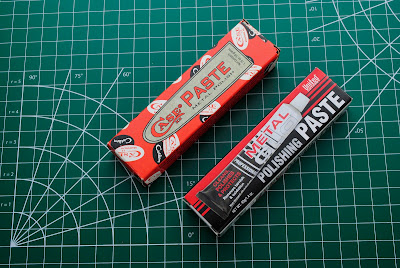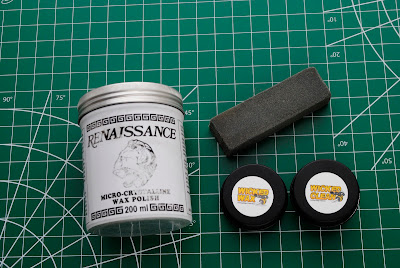You come to own a few knives, maybe more than a few, you'll discover you’re a knife collector. Smart knife fanciers know they need to take care of their investments.
Every folder
needs a drop of oil in its pivot, spring, or release. The same goes for any metal blade. Maybe your blade is a super stainless, or
perhaps it is a nice 1085 carbon steel, but it still needs a drop of oil. Stainless steels are literally called
stain-less because they are more resistant to rust, not impervious.
 |
| These are all non-food grade |
There is a sub-class of collectors that like to corrode their blades. They say they are adding a patina. I've heard collectors claim they like the patina older carbon blades form.
No matter what
you call it, it’s corrosion/oxidation.
Most corrosion is rust; to prevent it, we need to keep the steel dry and
protected. The easiest protection is
oil.
But what oil?
As Rhett told Scarlet,
"Frankly my dear, I don't give a damn." Almost any oil, 3 in 1, some high-tech
silicone or mystic rendered unicorn horn will work. The better question is, which will harm my
knife? And which ones are safe for food?
A few years ago,
everyone was excited about a mixture of hexane and paraffin wax. The hexane would evaporate, leaving a thin
coating of wax behind. This product was often
found lubricating bicycle chains. The
wax didn’t attract and hold dirt like sticky oils and was thought to be
cleaner. But I suggest you consider what
hexane could attack on your knife. At
the very least, hexane can attack some plastics and finish.
Food-safe oils
aren't that difficult to find. Basic mineral
oil is considered food-safe in small amounts.
If you anticipate your knife will be used to build a fire and prepare
your meal, food safety oil is an excellent idea. Giving yourself the Texas-two-step trots is
not survival-oriented or conducive to a good time at cabin or camp.
Check your label
in advance, if it doesn’t say food safe or safe for consumption, it isn’t.
Sooner or later, you'll need to clean your knives. Maybe there’s a little discoloration of brass from age or storage. Has your blade picked up a smudge of gunk, marks from sharpening a pencil, or a discoloration that needs to be removed?

I've polished a lot of electron microscope parts with this
Try a solvent like Goo-Gone first to remove pine tar, adhesives, and organic gunk. Super Erasers work well, but leave rubber sawdust everywhere.
Paste polish is
useful to bring back a shine. I’ve used
toothpaste, Simichrome paste, and several others for that purpose. They have advantages and disadvantages. The biggest is leaving a residue behind,
especially in checkered areas or other depressions too small for a rag to wipe
cleanly away. Simichrome often leaves a
reddish discoloration that is hard to wash clean. I found a rinse with 95% isopropyl alcohol
(that’s rubbing alcohol to most of us) removes the paste media. I follow up with hot water and a little detergent
to wash away the pigment.
 |
| More polishing paste |
But you need to get rid of that water, right? I hope so. I turn to WD-40. I generously hose the knife out over a trash can, and blow out the residue with compressed air or a hot air hairdryer.
 |
| WD-40...Good stuff when used properly |
Don't let it get too hot! Then, add a small drop of oil to all the moving parts, including the back springs. WD-40 isn't an oil; it's more of a surface treatment.
 |
| My old can of Renaissance Wax next to Wicker Cleaner and Wax. The gray reangle is a Super Eraser. |
Recently, I've been using Renaissance Wax to preserve surfaces. It's acid-free, which means it doesn't contain any organic acids that would react with brass, copper, and, to some degree, silver. They have a polishing form that contains very fine powdered chalk.
Chalk is just
calcium carbonate. It's very soft, so it
doesn't scratch metal, but we can use it to polish away slight oxidation like
the green verdigris.
I have used Wicked
Wax and Wicked Cleaner successfully. I
used the cleaner to polish an old Buck 110, which cleaned up the brass and gave
a nice shine to the wood.
I also treated
the Buck's leather pouch with Neatsfoot oil.
It's a natural product, and I didn't soak the leather; I just wiped it
inside and out.
Leather can be
damaged by salt, bacteria, and moisture.
All of these can occur when you use a knife. I've heard of people removing old, worn, or
damaged leather surfaces with very fine sandpaper. There are so many possible variations of how
manufacturers make leather washer handles that no simple procedure will fit
them all. On working knives with stacked
leather handles, I wipe them off with a damp cloth, followed by a dry cloth and
ambient air drying. A thin film of a
quality leather oil might be needed.
If necessary, I
wash my collectible knives with saddle soap, allow the leather to completely
dry, and wipe them down with Neetsfoot oil.
Neetsfoot oil is
a distillation of the long leg bones in cattle.
It is the closest natural plasticizer to leather there is. But I use it sparingly. Nobody likes soggy leather, which can happen
from too much oily treatment.
Wrapping your
knife in leather can be corrosive too.
Leather contains moisture and fatty acid salts that will attack brass
and copper.
For working
knives, I actually prefer synthetic handles, which I can wash, dry and go.
If you collect,
keep your knives where they are cool, dry, and protected so they don't scratch
each other. There are soft single knife
pouches available that protect and save your knives. Take advantage of them.
Working knives
should be sharpened when needed, cleaned and oiled when dirty or wet, and made
ready for more use.
I used to go to
a flea market where Richard would display metal tools and steel vices. All of
them were rusted from being left out in the rain, significantly dropping
interest and value. Don’t be like Dick. Protect your investment.
